First Aid for Soldiers FM 21-11
FM 21-11 First Aid for Soldiers: Chapter 7
First Aid in Toxic Environments
Headquarters, Department of the Army, Washington, D.C., October 27, 1988
INTRODUCTION
American forces have not been exposed to high levels of toxic substances on the
battlefield since World War I. In future conflicts and wars we can expect the use of such
agents. Chemical weapons will degrade unit effectiveness rapidly by forcing troops to wear
hot protective clothing and by creating confusion and fear. Through training in protective
procedures and first aid, units can maintain their effectiveness on the integrated
battlefield.
FOR TOXIC SUBSTANCES
a. Gasoline, chlorine, and pesticides are examples of common toxic substances.
They may exist as solids, liquids, or gases depending upon temperature
and pressure. Gasoline, for example, is a vaporizable liquid; chlorine is a gas;
and Warfarin, a pesticide, is a solid. Some substances are more injurious to the
body than others when they are inhaled or eaten or when they contact the skin or eyes.
Whether they are solids, liquids, or gases (vapors and aerosols included), they may
irritate, inflame, blister, burn, freeze, or destroy tissue such as that associated with
the respiratory tract or the eyes. They may also be absorbed into the bloodstream,
disturbing one or several of the body's major functions.
b. You may come in contact with toxic substances in combat or in everyday
activities. Ordinarily, brief exposures to common household toxic substances, such as
disinfectants and bleach solutions, do not cause injuries. Exposure to toxic chemical
agents in warfare, even for a few seconds, could result in death, injury, or
incapacitation. Remember that toxic substances employed by an enemy could persist for
hours or days. To survive and operate effectively in a toxic environment, you must be
prepared to protect yourself from the effects of chemical agents and to provide first aid
to yourself and to others.
You are issued equipment for protection and first aid treatment in a toxic environment.
You must know how to use the items described in a
through e. It is equally important that you know when to use them. Use your
protective clothing and equipment when you are ordered to and when you are under a
nuclear, biological, or chemical (NBC) attack. Also, use your protective clothing and
equipment when you enter an area where NBC agents have been employed.
a. Field Protective Mask With Protective Hood. Your field
protective mask is the most important piece of protective equipment. You are given special
training in its use and care.
b. Field Protective Clothing. Each soldier is authorized three sets of the
following field protective clothing:
-
Overgarment ensemble (shirt and trousers), chemical protective.
-
Footwear cover (overboots), chemical protective.
-
Glove set, chemical protective.
c. Nerve Agent Pyridostigmine Pretreatment (NAPP). You will be issued a
blister pack of pretreatment tablets when your commander directs. When ordered to take the
pretreatment you must take one tablet every eight hours. This must be taken prior to
exposure to nerve agents, since it may take several hours to develop adequate blood
levels.
NOTE
Normally, one set of protective clothing is used in acclimatization training that uses
various mission-oriented protective posture (MOPP) levels.
d. M258A1 Skin Decontamination Kit. The M258A1 Skin Decontamination (decon)
Kit contains three each of the following:
-
DECON-1 packets containing wipes (pads) moistened with decon solution.
-
DECON-2 packets containing dry wipes (pads) previously moistened with decon solution and
sealed glass ampules. Ampules are crushed to moisten pads.
WARNING
The decon solution contained in both DECON-1 and DECON-2 packets is a poison
and caustic hazard and can permanently damage the eyes. Keep wipes out of the eyes,
mouth, and open wounds. Use WATER to wash toxic agent out of eyes and wounds
and seek medical aid.
e. Nerve Agent Antidote Kit, Mark I (NAAK MKI). Each soldier is authorized to
carry three Nerve Agent Antidote Kits, Mark I, to treat nerve agent poisoning. When NAPP
has been taken several hours (but no greater than 8 hours) prior to exposure, the NAAK MKI
treatment of nerve agent poisoning is much more effective.
a. Chemical agents may be classified according to the primary physiological
effects they produce, such as nerve, blister, blood, choking, vomiting, and incapacitating
agents.
b. Biological agents may be classified according to the effect they have on
man. These include blockers, inhibitors, hybrids, and membrane active compounds. These
agents are found in living organisms such as fungi, bacteria and viruses.
WARNING
Ingesting water or food contaminated with nerve, blister, and other chemical agents and
with some biological agents can be fatal. NEVER consume water or food which is
suspected of being contaminated until it has been tested and found safe for consumption.
Once an attack with a chemical or biological agent is detected or suspected, or
information is available that such an agent is about to be use, you must STOP
breathing and mask immediately. DO NOT WAIT to receive an order or alarm
under the following circumstances:
-
Your position is hit by artillery or mortar fire, missiles, rockets, smokes, mists,
aerial sprays, bombs, or bomblets.
-
Smoke from an unknown source is present or approaching.
-
A suspicious odor, liquid, or solid is present.
-
A toxic chemical or biological attack is present.
-
You are entering an area known or suspected of being contaminated.
-
During any motor march, once chemical warfare has begun.
-
When casualties are being received from an area where chemical or biological agents have
reportedly been used.
-
You have one or more of the following symptoms:
o An unexplained runny nose.
o A feeling of choking or tightness in the chest or throat.
o Dimness of vision.
o Irritation of the eyes.
o Difficulty in or increased rate of breathing without obvious reasons.
o Sudden feeling of depression.
o Dread, anxiety, restlessness.
o Dizziness or light-headedness.
o Slurred speech.
-
Unexplained laughter or unusual behavior is noted in others.
-
Numerous unexplained ill personnel.
-
Buddies suddenly collapsing without evident cause.
-
Animals or birds exhibiting unusual behavior and/or sudden unexplained death.
For further information, see FM 3-4.
Your field protective mask gives protection against chemical as well as biological
agents. Previous practice enables you to mask in 9 seconds or less or to put on your mask
with hood within 15 seconds.
|
a. Step ONE (081-831-1030 and 081-831-1031). Stop breathing. Don your mask,
seat it properly, clear and check your mask, and resume breathing. Give the alarm, and
continue the mission. Keep your mask on until the "all clear" signal has been
given. |
NOTE
|
b. Step TWO (081-831-1030). If symptoms of nerve agent poisoning (paragraph 7-7) appear, immediately give yourself a nerve
agent antidote. You should have taken NAPP several hours prior to exposure which will
enhance the action of the nerve agent antidote. |
CAUTION
|
c. Step THREE (081-831-1031). If your eyes and face become contaminated, you
must immediately try to get under cover. You need this shelter to prevent further
contamination while performing decon procedures on areas of the head. If no overhead cover
is available, throw your poncho or shelter half over your head before beginning the decon
process. Then you should put on the remaining protective clothing. (See Appendix F for decon procedure.) If vomiting occurs, the mask
should be lifted momentarily and drained--while the eyes are closed and the breath is
held--and replaced, cleared, and sealed. |
d. Step FOUR. If nerve agents are used, mission permitting watch for persons
needing nerve agent antidotes and immediately follow procedures outlined in paragraph 7-8b.
e. STEP FIVE. When your mission permits, decon your clothing and equipment.
a. Nerve agents are among the deadliest of chemical agents They can be
delivered by artillery shell, mortar shell, rocket, missile landmine, and aircraft bomb,
spray, or bomblet. Nerve agents enter the body by inhalation, by ingestion, and through
the skin. Depending on the route of entry and the amount, nerve agents can produce injury
or death within minutes. Nerve agents also can achieve their effects with small amounts.
Nerve agents are absorbed rapidly, and the effects are felt immediately upon entry into
the body. You will be issued three Nerve Agent Antidote Kits, Mark I. Each kit consists of
one atropine autoinjector and one pralidoxime chloride (2 PAM Cl) autoinjector (also
called injectors) (Figure 7-1).
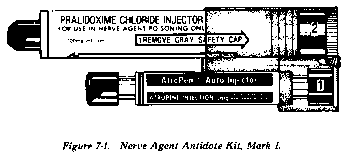
b. When you have the signs and symptoms of nerve agent poisoning, you should
immediately put on the protective mask and then inject yourself with one set of the Nerve
Agent Antidote Kit, Mark I. You should inject yourself in the outside (lateral) thigh
muscle or if you are thin, in the upper outer (lateral) part of the buttocks.
c. Also, you may come upon an unconscious chemical agent casualty who will be
unable to care for himself and who will require your aid. You should be able to
successfully--
(1) Mask him if he is unmasked.
(2) Inject him, if necessary, with all his autoinjectors.
(3) Decontaminate his skin.
(4) Seek medical aid.
|
The symptoms of nerve agent poisoning are grouped as MILD--those which you recognize
and for which you can perform self-aid, and SEVERE--those which require buddy aid.
a. MILD Symptoms (081-831-1030).
-
Unexplained runny nose.
-
Unexplained sudden headache.
-
Sudden drooling.
-
Difficulty seeing (blurred vision).
-
Tightness in the chest or difficulty in breathing.
-
Localized sweating and twitching (as a result of small amount of nerve agent on skin).
-
Stomach cramps.
-
Nausea.
b. SEVERE Signs/Symptoms (081-831-1031).
-
Strange or confused behavior.
-
Wheezing, difficulty in breathing, and coughing.
-
Severely pinpointed pupils.
-
Red eyes with tearing (if agent gets into the eyes).
-
Vomiting.
-
Severe muscular twitching and general weakness.
-
Loss of bladder/bowel control.
-
Convulsions.
-
Unconsciousness.
-
Stoppage of breathing.
|
The injection site for administering the Nerve Agent Antidote Kit, Mark I (see Figure 7-1), is normally in the outer thigh muscle (see Figure 7-2). It is important that the injections be given into a large
muscle area. If the individual is thinly-built, then the injections must be administered
into the upper outer quarter (quadrant) of the buttocks (see Figure 7-3).
This avoids injury to the thigh bone.

WARNING
There is a nerve that crosses the buttocks, so it is important to inject only
into the upper
outer quadrant (see Figure 7-3). This will avoid injuring this
nerve. Hitting the nerve can
cause paralysis.

|
a. Self-Aid (081 831-1030).
(1) Immediately put on your protective mask after identifying any of the signs/symptoms
of nerve agent poisoning (paragraph 7-7).
(2) Remove one set of the Nerve Agent Antidote Kit, Mark I.
(3) With your nondominant hand, hold the autoinjectors by the plastic clip so that the
larger autoinjector is on top and both are positioned in front of you at eye level (see Figure 7-4).
|

(4) With the other hand, check the injection site (thigh or buttocks) for buttons or
objects in pockets which may interfere with the injections.
(5) Grasp the atropine (smaller) autoinjector with the thumb and first two fingers (see
Figure 7-5).
|
CAUTION
DO NOT cover/hold the green (needle) end with your hand or fingers--you might
accidentally inject yourself.
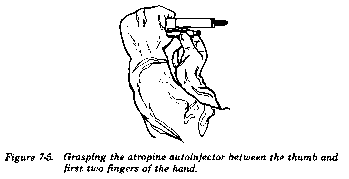
|
WARNING
The injector is now armed. DO NOT touch the green (needle) end.
|
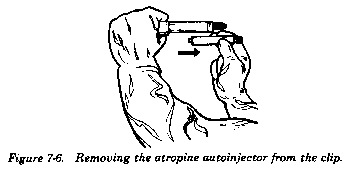
(7) Form a fist around the autoinjector. BE CAREFUL NOT TO INJECT YOURSELF IN THE HAND!
(8) Position the green end of the atropine autoinjector against the injection site
(thigh or buttocks):
|
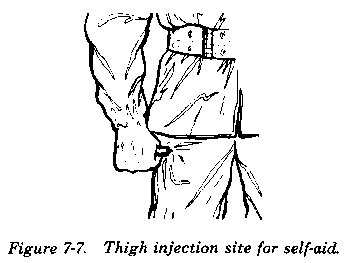
OR
(b) On the upper outer portion of the buttocks (see Figure
7-8).
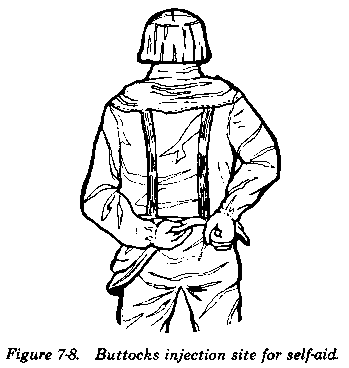
(9) Apply firm, even pressure (not a jabbing motion) to the injector until it pushes
the needle into your thigh (or buttocks).
|
WARNING
NOTE
Firm pressure automatically triggers the coiled spring mechanism. This plunges the
needle through the clothing into the muscle and injects the fluid into the muscle tissue.
(10) Hold the injector firmly in place for at least ten seconds. The ten seconds can be
estimated by counting "one thousand and one, one thousand and two," and so
forth.
(11) Carefully remove the autoinjector.
(12) Place the used atropine injector between the little finger and the ring finger of
the hand holding the remaining autoinjector and the clip (see Figure 7-9).
WATCH OUT FOR THE NEEDLE!
|
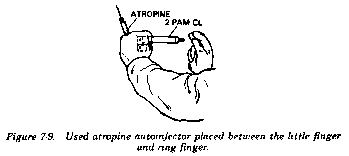
(13) Pull the 2 PAM C1 autoinjector (the larger of the two injectors) out of the clip
(see Figure 7-10) and inject yourself in the same manner as steps (7) through (11) above, holding the black (needle)
end against your thigh (or buttocks).
|
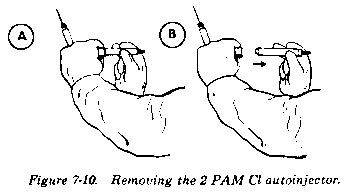
(14) Drop the empty injector clip without dropping the used autoinjectors.
(15) Attach the used injectors to your clothing (see Figure 7-11).
Be careful NOT to tear your protective gloves/clothing with the needles.
|
WARNING
It is important to keep track of all used autoinjectors so that medical personnel can
determine how much antidote has been given and the proper follow-up treatment can be
provided, if needed.

WARNING
If within 5 to 10 minutes after administering the first set of injections, your heart
begins
to beat rapidly and your mouth becomes very dry, DO NOT give yourself another set
of injections. You have already received enough antidote to overcome the dangerous
effects of the nerve agent. If you are able to walk without assistance (ambulate), know
who you are and where you are, you WILL NOT need the second set of injections.
(If not needed, giving yourself a second set of injections may create a nerve agent
antidote overdose, which could cause incapacitation.) If, however, you continue to
have symptoms of nerve agent poisoning for 10 to 15 minutes after receiving one set
of injections, seek a buddy to check your symptoms. If your buddy agrees that your
symptoms are worsening, administer the second set of injections.
NOTE (081-831-1030)
While waiting between sets (injections), you should decon your skin, if necessary, and
put on the remaining protective clothing.
|
b. Buddy aid (081-831-1031)
A soldier exhibiting SEVERE signs/symptoms of nerve agent poisoning will not be able to
care for himself and must therefore be given buddy aid as quickly as possible. Buddy aid
will be required when a soldier is totally and immediately incapacitated prior to being
able to apply self-aid, and all three sets of his Nerve Agent Antidote Kit, Mark I, need
to be given by a buddy. Buddy aid may also be required after a soldier attempted to
counter the nerve agent by self-aid but became incapacitated after giving himself one set
of the autoinjectors. Before initiating buddy aid, a buddy should determine if one set of
injectors has already been used so that no more than three sets of the antidote are
administered.
WARNING
(2) Remove the casualty's protective mask from the carrier.
(3) Position yourself above the casualty's head, facing his feet.
|
WARNING
Squat, DO NOT kneel, when masking a chemical agent casualty. Kneeling may force
the chemical agent into or through your protective clothing, which will greatly reduce the
effectiveness of the clothing.
(4) Place the protective mask on the casualty.
(5) Have the casualty clear the mask.
(6) Check for a complete mask seal by covering the inlet valves. If properly sealed the
mask will collapse.
|
NOTE
If the casualty is unable to follow instructions, is unconscious, or is not breathing,
he will
not be able to perform steps (5) or (6). It may
therefore, be impossible to determine if
the mask is sealed. But you should still try to check for a good seal by placing
your
hands over the valves.
(7) Pull the protective hood over the head, neck, and shoulders of the casualty.
(8) Position yourself near the casualty's thigh.
(9) Remove one set of the casualty's autoinjectors.
|
NOTE (081-831-1031)
Use the CASUALTY'S autoinjectors. DO NOT use YOUR autoinjectors for
buddy aid;
if you do, you may not have any antidote if/when needed for self-aid.
(10) With your nondominant hand, hold the set of autoinjectors by the plastic clip so
that the larger autoinjector is on top and both are positioned in front of you at eye
level (see Figure 7-4).
(11) With the other hand, check the injection site (thigh or buttocks) for buttons or
objects in pockets which may interfere with the injections.
(12) Grasp the atropine (smaller) autoinjector with the thumb and first two fingers
(see Figure 7-5).
|
CAUTION
DO NOT cover/hold the green (needle) end with your hand or fingers--you may
accidentally inject yourself.
WARNING
The injector is now armed. DO NOT touch the green (needle) end.
WARNING
Holding or covering the needle (green) end of the autoinjector may result in
accidentally injecting yourself.
(15) Position the green end of the atropine autoinjector against the injection site
(thigh or buttocks):
(a) On the casualty's outer thigh muscle (see Figure 7-12)
|
NOTE
The injections are normally given in the casualty's thigh.
WARNING
If this is the injection site used, be careful not to inject him close to the hip,
knee, or thigh bone.
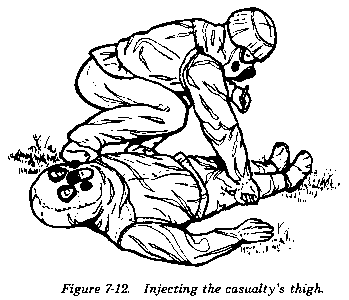
OR
(b) On the upper outer portion of the casualty's buttocks (see Figure 7-13).
NOTE
If the casualty is thinly built, reposition him onto his side or stomach and inject the
antidote into his buttocks.
|
WARNING
Inject the antidote only into the upper outer portion of his buttocks (see Figure 7-13).
This avoids hitting the nerve that crosses the buttocks. Hitting this nerve can cause
paralysis.
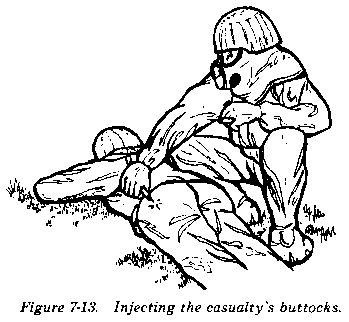
(16) Apply firm, even pressure (not a jabbing motion) to the injector to activate the
needle. This causes the needle to penetrate both the casualty's clothing and muscle.
|
WARNING
(17) Hold the injector firmly in place for at least ten seconds. The ten seconds can be
estimated by counting "one thousand and one, one thousand and two," and so
forth.
(18) Carefully remove the autoinjector.
(19) Place the used autoinjector between the little finger and ring finger of the hand
holding the remaining autoinjector and the clip (see Figure 7-9).
WATCH OUT FOR THE NEEDLE!
(20) Pull the 2 PAM Cl autoinjector (the larger of the two injectors) out of the clip
(see Figure 7-10) and inject the casualty in the same manner as steps (9) through (19) above, holding the black (needle)
end against the casualty's thigh (or buttocks).
(21) Drop the clip without dropping the used autoinjectors.
(22) Carefully lay the used injectors on the casualty's chest (if he is lying on his
back), or on his back (if he is lying on his stomach), pointing the needles toward his
head.
(23) Repeat the above procedure immediately (steps (9)
through (22)), using the second and third set of autoinjectors.
(24) Attach the three sets of used autoinjectors to the casualty's clothing (see Figure 7-14). Be careful NOT to tear either your or the casualty's
protective clothing/gloves with the needles.
|
WARNING
It is important to keep track of all used autoinjectors so that medical personnel will
be
able to determine how much antidote has been given and the proper follow-up treatment
can be provided, if needed.

Blister agents (vesicants) include mustard (HD), nitrogen mustards (HN), lewisite (L),
and other arsenicals, mixtures of mustards and arsenicals, and phosgene oxime (CX).
Blister agents act on the eyes mucous membranes, lungs, and skin. They burn and blister
the skin or any other body parts they contact. Even relatively low doses may cause serious
injury. Blister agents damage the respiratory tract (nose, sinuses and windpipe) when
inhaled and cause vomiting and diarrhea when absorbed. Lewisite and phosgene oxime cause
immediate pain on contact. However, mustard agents are deceptive and there is little or no
pain at the time of exposure. Thus in some cases, signs of injury may not appear for
several hours after exposure.
a. Protective Measures. Your protective mask with hood and protective
overgarments provide you protection against blister agents. If it is known or suspected
that blister agents are being used, STOP BREATHING, put on your mask and all your
protective overgarments.
CAUTION
Large drops of liquid vesicants on the protective overgarment ensemble may penetrate
it if allowed to stand for an extended period. Remove large drops as soon as possible.
b. Signs/Symptoms of Blister Agent Poisoning.
(1) Immediate and intense pain upon contact (lewisite and phosgene oxime). No
initial pain upon contact with mustard.
(2) Inflammation and blisters (burns)--tissue destruction. The severity of a
chemical burn is directly related to the concentration of the agent and the duration of
contact with the skin. The longer the agent is in contact with the tissue, the more
serious the injury will be.
(3) Vomiting and diarrhea. Exposure to high concentrations of vesicants may
cause vomiting and/or diarrhea.
(4) Death. The blister agent vapors absorbed during ordinary field exposure
will probably not cause enough internal body (systemic) damage to result in death.
However, death may occur from prolonged exposure to high concentrations of vapor or from
extensive liquid contamination over wide areas of the skin, particularly when decon is
neglected or delayed.
c. First Aid Measures.
(1) Use your M258A1 decon kit to decon your skin and use water to flush contaminated
eyes. Decontamination of vesicants must be done immediately (within 1 minute is best).
(2) If blisters form, cover them loosely with a field dressing and secure the dressing.
CAUTION
(3) If you receive blisters over a wide area of the body, you are considered seriously
burned. SEEK MEDICAL AID IMMEDIATELY.
(4) If vomiting occurs, the mask should be lifted momentarily and drained--while the
eyes are closed and the breath is held--and replaced, cleared, and sealed.
(5) Remember, if vomiting or diarrhea occurs after having been exposed to blister
agents, SEEK MEDICAL AID IMMEDIATELY.
Chemical agents that attack lung tissue, primarily causing fluid buildup (pulmonary
edema), are classified as choking agents (lung-damaging agents). This group includes
phosgene (CG), diaphosgene (DP), chlorine (CL), and chloropicrin (PS). Of these four
agents, phosgene is the most dangerous and is more likely to be employed by the enemy in
future conflict.
a. Protective Measures. Your protective mask gives adequate protection against
choking agents.
b. Signs/Symptoms. During and immediately after exposure to choking agents
(depending on agent concentration and length of exposure), you may experience some or all
of the following signs/symptoms:
-
Tears (lacrimation).
-
Dry throat.
-
Coughing.
-
Choking.
-
Tightness of chest.
-
Nausea and vomiting.
-
Headaches.
c. First Aid Measures.
(1) If you come in contact with phosgene, your eyes become irritated, or a cigarette
becomes tasteless or offensive, STOP BREATHING and put on your mask immediately.
(2) If vomiting occurs, the mask should be lifted momentarily and drained--while the
eyes are closed and the breath is held--replaced, cleared, and sealed.
(3) Seek medical assistance if any of the above signs/symptoms occur.
NOTE
If you have no difficulty breathing, do not feel nauseated, and have no more than the
usual shortness of breath on exertion, then you inhaled only a minimum amount of the
agent. You may continue normal duties.
d. Death. With ordinary field exposure to choking agents, death will probably
not occur. However, prolonged exposure to high concentrations of the vapor and neglect
or delay in masking can be fatal.
Blood agents interfere with proper oxygen utilization in the body. Hydrogen cyanide
(AC) and cyanogen chloride (CK) are the primary agents in this group.
a. Protective Measures. Your protective mask with a fresh filter gives
adequate protection against field concentrations of blood agent vapor. The protective
overgarment as well as the mask are needed when exposed to liquid hydrogen cyanide.
b. Signs/Symptoms. During and immediately after exposure to blood agents
(depending on agent Concentration and length of exposure), you may experience some or all
of the following signs/symptoms:
c. First Aid Measures.
(1) Hydrogen cyanide. During any chemical attack, if you get a sudden
stimulation of breathing or notice an odor like bitter almonds, PUT ON YOUR MASK
IMMEDIATELY. Speed is absolutely essential since this agent acts so rapidly that within a
few seconds its effects will make it impossible for individuals to put on their mask by
themselves. Stop breathing until the mask is on, if at all possible. This may
be very difficult since the agent strongly stimulates respiration.
(2) Cyanogen chloride. PUT ON YOUR MASK IMMEDIATELY if you experience any
irritation of the eyes, nose, or throat.
d. Medical Assistance. If you suspect that you have been exposed to blood
agents, seek medical assistance immediately.
Generally speaking, an incapacitating agent is any compound which can interfere with
your performance. The agent affects the central nervous system and produces muscular
weakness and abnormal behavior. It is likely that such agents will be disseminated by
smoke-producing munitions or aerosols, thus making breathing their means of entry into the
body. The protective mask is, therefore, essential.
a. There is no special first aid to relieve the symptoms of incapacitating
agents. Supportive first aid and physical restraint may be indicated. If the casualty is
stuporous or comatose, be sure that respiration is unobstructed; then turn him on his
stomach with his head to one side (in case vomiting should occur). Complete cleansing of
the skin with soap and water should be done as soon as possible; or, the M258A1 Skin
Decontamination Kit can be used if washing is impossible. Remove weapons and other
potentially harmful items from the possession of individuals who are suspected of having
these symptoms. Harmful items include cigarettes, matches, medications, and small items
which might be swallowed accidentally. Delirious persons have been known to attempt to eat
items bearing only a superficial resemblance to food.
b. Anticholinergic drugs (BZ-type) may produce alarmingdryness and coating of
the lips and tongue; however, there is usually no danger of immediate dehydration. Fluids
should be given sparingly, if at all, because of the danger of vomiting and because of the
likelihood of temporary urinary retention due to paralysis of bladder muscles. An
important medical consideration is the possibility of heatstroke caused by the stoppage of
sweating. If the environmental temperature is above 78¡ F, and the situation permits,
remove excessive clothing from the casualty and dampen him to allow evaporative cooling
and to prevent dehydration. If he does not readily improve, apply first aid measures for
heatstroke and seek medical attention.
Incendiaries can be grouped as white phosphorus, thickened fuel, metal, and oil and
metal. You must learn to protect yourself against these incendiaries.
a. White phosphorus (WP) is used primarily as a smoke producer but can be used
for its incendiary effect to ignite field expedients and combustible materials. The burns
from WP are usually multiple, deep, and variable in size. When particles of WP get on the
skin or clothing, they continue to burn until deprived of air. They also have a tendency
to stick to a surface and must be brushed off or picked out.
(1) If burning particles of phosphorus strike and stick to your clothing, quickly take
off the contaminated clothing before the phosphorus burns through to the skin.
(2) If burning phosphorus strikes your skin, smother the flame by submerging yourself
in water or by dousing the WP with water from your canteen or any other source. Urine, a
wet cloth, or mud can also be used.
NOTE
Since WP is poisonous to the system, DO NOT use grease or oil to smother the flame.
The WP will be absorbed into the body with the grease or oil.
(3) Keep the WP particles covered with wet material to exclude air until you can remove
them or get them removed from your skin.
(4) Remove the WP particles from the skin by brushing them with a wet cloth and by
picking them out with a knife, bayonet, stick, or other available object.
(5) Report to a medical facility for treatment as soon as your mission permits.
b. Thickened fuel mixtures (napalm) have a tendency to cling to clothing and
body surfaces, thereby producing prolonged exposure and severe burns. The first aid for
these burns is the same as for other heat burns. The heat and irritating gases given off
by these combustible mixtures may cause lung damage, which must be treated by a medical
officer.
c. Metal incendiaries pose special problems. Thermite and thermate particles
on the skin should be immediately cooled with water and then removed. Even though thermate
particles have their own oxygen supply and continue to burn under water, it helps to cool
them with water. The first aid for these burns is the same as for other heat burns.
Particles of magnesium on the skin burn quickly and deeply. Like other metal incendiaries,
they must be removed. Ordinarily, the complete removal of these particles should be done
by trained personnel at a medical treatment facility, using local anesthesia. Immediate
medical treatment is required.
d. Oil and metal incendiaries have much the same effect on contact with the
skin and clothing as those discussed (b and c above). Appropriate first
aid measures for burns are described in Chapter 3.
We are concerned with victims of biological attacks and with treating symptoms after
the soldier becomes ill. However, we are more concerned with preventive medicine and
hygienic measures taken before the attack. By accomplishing a few simple tasks we can
minimize their effects.
a. Immunizations. In the military we are accustomed to keeping inoculations up
to date. To prepare for biological defense, every effort must be taken to keep
immunizations current. Based on enemy capabilities and the geographic location of our
operations, additional immunizations may be required.
b. Food and Drink. Only approved food and water should be consumed. In a
suspected biological warfare environment, efforts in monitoring food and water supplies
must be increased. Properly treated water and properly cooked food will destroy most
biological agents.
c. Sanitation Measures.
(1) Maintain high standards of personal hygiene. This will reduce the
possibility of catching and spreading infectious diseases.
(2) Avoid physical fatigue. Physical fatigue lowers the body's resistance to
disease. This, of course, is complemented by good physical fitness.
(3) Stay out of quarantined areas.
(4) Report sickness promptly. This ensures timely medical treatment and, more
importantly, early diagnosis of the disease.
d. Medical Treatment of Casualties. Once a disease is identified, standard
medical treatment commences. This may be in the form of first aid or treatment at a
medical facility, depending on the seriousness of the disease. Epidemics of serious
diseases may require augmentation of field medical facilities.
Toxins are alleged to have been used in recent conflicts. Witnesses and victims have
described the agent as toxic rain (or yellow rain) because it was reported to have been
released from aircraft as a yellow powder or liquid that covered the ground, structures,
vegetation, and people.
a. Protective Measures. Individual protective measures normally associated
with persistent chemical agents will provide protection against toxins. Measures include
the use of the protective mask with hood, and the overgarment ensemble with gloves and
overboots (mission-oriented protective posture level-4 [MOPP 4]).
b. Signs/Symptoms. The occurrence of the symptoms from toxins may appear in a
period of a few minutes to several hours depending on the particular toxin, the individual
susceptibility, and the amount of toxin inhaled, ingested, or deposited on the skin.
Symptoms from toxins usually involve the nervous system but are often preceded by less
prominent symptoms, such as nausea, vomiting, diarrhea, cramps, or burning distress of the
stomach region. Typical neurological symptoms often develop rapidly in severe cases, for
example, visual disturbances, inability to swallow, speech difficulty, muscle
coordination. and sensory abnormalities (numbness of mouth, throat, or extremities).
Yellow rain (mycotoxins) also may have hemorrhagic symptoms which could include any/all of
the following:
-
Dizziness.
-
Severe itching or tingling of the skin.
-
Formation of multiple, small, hard blisters.
-
Coughing up blood.
-
Shock (which could result in death).
c. First Aid Measures. Upon recognition of an attack employing toxins or the
onset (start) of symptoms listed above, you must immediately take the following actions:
(1) Step ONE. STOP BREATHING, put on your protective mask with hood, then
resume breathing. Next, put on your protective clothing.
(2) Step TWO. Should severe itching of the face become unbearable, quickly--
-
Loosen the cap on your canteen.
-
Remove your helmet. Take and hold a deep breath and remove your mask.
-
While holding your breath, close your eyes and flush your face with generous amounts of
water.
CAUTION
DO NOT rub or scratch your eyes. Try not to let the water run onto your clothing or
protective overgarments.
NOTE
The effectiveness of the M258A1 Skin Decon Kit for biological agent decon is
unknown at this time; however, flushing the skin with large amounts of water will reduce
the effectiveness of the toxins.
(3) Step THREE. If vomiting occurs, the mask should be lifted momentarily and
drained--while the eyes are closed and the breath is held--and replaced, cleared, and
sealed.
d. Medical Assistance. If you suspect that you have been exposed to toxins, you
should seek medical assistance immediately.
There is no direct first aid for radiological casualties. These casualties are treated
for their apparent conventional symptoms and injuries.
|
















